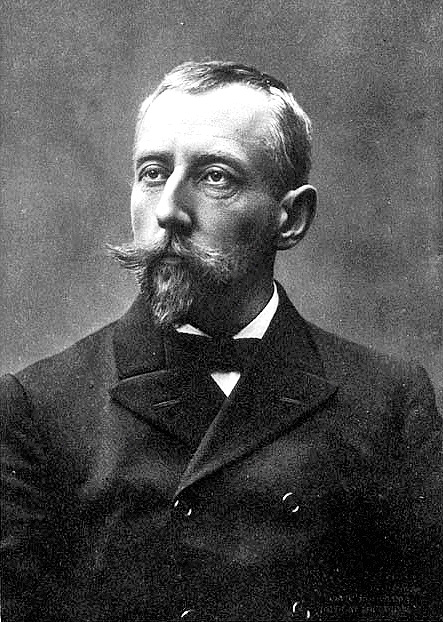 |
| Roald Amundsen, ~1904 (aged ~32) |
Roald Engelbregt Gravning Amundsen (July 16, 1872--June 18, 1928) was a Norwegian explorer of polar regions. He led the Antarctic expedition in 1911--1912 which first reached the South Pole.
Amundsen was born to a family of Norwegian shipowners and captains. Inspired by Fridtjof Nansen's crossing of Greenland in 1888 he decided on a life of exploration.
First expeditions
He joined the Belgian Antarctic Expedition (1897--1899) as second mate. Led by Adrien de Gerlache, their ship the Belgica became the first to winter in Antarctica. Also on board was an American doctor, Frederick Cook. Cook probably saved the crew from scurvy, an important lesson for Amundsen's future expeditions.
In 1903 Amundsen led the first expedition to traverse the Northwest Passage between the Atlantic and Pacific Oceans, with 6 others in the ship Gjøa. They traveled via Baffin Bay, Lancaster and Peel Sounds, and James Ross and Rae Straits to spend two winters exploring over land and ice from the place today called Gjoa Haven, Nunavut, Canada. During this time Amundsen studied the local Netsilik people in order to learn Arctic survival skills and soon adopted their dress. From them he learned to use sled dogs. Continuing to the south of Victoria Island, the ship cleared the Arctic Archipelago on August 17, 1905, but had to stop for the winter before going on to Nome on the Alaska Territory's Pacific coast. 500 miles (800 km) away, Eagle City, Alaska, had a telegraph station; Amundsen traveled there (and back) overland to wire a success message (collect) on December 5, 1905. Nome was reached in 1906. Due to water as shallow as 3 feet (1 m), a larger ship could never have used the route.
The South Pole
After the Northwest Passage Amundsen made plans to go to the North Pole. On hearing in 1909 that first Cook and then Robert Peary claimed the Pole, he changed his plans. Using Fridtjof Nansen's ship Fram he set out for Antarctica instead in 1910. His party wintered on the Ross Ice Shelf at a location known as the Bay of Whales. Amundsen named the base "Framheim", literally, "Home of the Fram." It was 60 miles closer to the Pole than McMurdo Sound where the rival British expedition led by Robert Falcon Scott stayed. But Scott had a route, discovered by Ernest Shackleton, up the Beardmore Glacier to the Antarctic Plateau. Amundsen would have to find his own path through the Trans-Antarctic Mountains.
Amundsen began his drive for the pole on October 20, 1911, and along with Olav Bjaaland, Helmer Hanssen, Sverre Hassel, and Oscar Wisting, arrived at the Pole on December 14, 1911, 35 days before Scott. Scott had the misfortune to find Amundsen's tent and his letter upon arrival. Amundsen's extensive experience, preparation, and use of the best sled dogs available paid off in the end. In contrast to the misfortunes of the Scott expedition, the Amundsen expedition proved rather smooth and uneventful.
As neither expedition carried the very bulky wireless telegraphy equipment which would then have been the only way to communicate directly from the Pole, Amundsen's success was not publicly announced until March 7, 1912. Amundsen recounted his journey in the book The South Pole: An Account of the Norwegian Antarctic Expedition in the "Fram", 1910--1912.
Later life
In 1918 Amundsen began an expedition with a new ship Maud to explore the North East Passage. It did not meet its goals and was considered a failure. In 1925 with Lincoln Ellsworth and four others he flew to 87° 44' north in two airplanes. It was the northernmost latitude reached by airplane up to that time. The following year Amundsen, Ellsworth and Italian aeronautical engineer Umberto Nobile made the first crossing of the Arctic in the airship Norge designed by Nobile. They left Spitzbergen May 11, 1926 and landed in Alaska two days later.
Amundsen died in 1928 in an airplane crash in the Arctic Ocean while on a rescue mission for Nobile, whose next airship the Italia had crashed. Amundsen's airplane was never found.
Source: http://www.biographybase.com/biography/Amundsen_Roald.html
From what little I've read of the era, explorers from the 19th century used one of three different approaches to meet their physiological needs (e.g. food, warmth, water) as they travelled into unknown terrain. Each approach has it's pros and cons (like all things in this heavily, but not totally, dualistic universe), and so each are superior in one regard and inferior in another. Swings and roundabouts as they say; much like the various polytheistic gods around the world.
- Men like Roald Amundsen learnt existing bush-craft methods from locals (the Netsilik people). Which shows that he respects other peoples culture and is humble enough to learn from them; it also shows that he is less willing to try his own methods and learn for himself.
- Men like John MacDouall Stuart learnt new bush-craft methods by himself. Which shows that he is willing to take risks even if it means suffering in the process; it also shows a certain stubbornness and sense of superiority that he is less willing to humble himself before other people and learn from them.
- Men like Sir John Franklin didn't learn any bush-craft methods, but relied on the latest technology. Which shows that he is willing to use the best technology to keep himself and his crewmen alive throughout the expedition; it also shows a total unwillingness to interact with the physical terrain itself (a certain aloofness you might say), which in the case of Sir Franklin case was his undoing (as his expedition to find the Northwest Passage was a total disaster).
[End.]
No comments:
Post a Comment